Home Gardenscapes as Sustainable Landscape Management on St. Eustatius, Dutch Caribbean
Abstract
:1. Introduction
2. Materials and Methods
2.1. Study Area
2.2. Selection of Gardens and Participants
2.3. Ecological and Ethnobotanical Plant Diversity
2.4. Gaining Local Perceptions on Gardenscapes
3. Results
3.1. Ecological and Cultural Diversity of the Gardenscapes
3.2. Local Perceptions on the Management and Livelihood Contributions of Gardenscapes
4. Discussion
4.1. Gardenscapes for Biodiversity Conservation
4.2. Gardeners Create Diverse and Meaningful Gardenscapes
5. Conclusions
Supplementary Materials
Acknowledgments
Author Contributions
Conflicts of Interest
References
- Zimmerer, K.S.; Young, K.R. Introduction: The geographical nature of landscape change. In Nature’s Geography: New Lessons for Conservation in Developing Countries; Zimmerer, K.S., Young, K.R., Eds.; University of Wisconsin Press: Madison, WI, USA, 1998; pp. 3–34. [Google Scholar]
- Hamilton, A.; Hamilton, P. Plant Conservation: An Ecosystem Approach; Earthscan: London, UK, 2006. [Google Scholar]
- Fabricius, C.; Folke, C.; Cundill, G.; Schultz, L. Powerless spectators, coping actors, and adaptive co-managers: A synthesis of communities in ecosystem management. Ecol. Soc. 2007, 12, 29. [Google Scholar] [CrossRef]
- Fagerholm, N.; Kayhko, N.; Ndumbaro, F.; Khamis, M. Community stakeholders’ knowledge in landscape assessments—Mapping indicators for landscape services. Ecol. Indic. 2012, 18, 421–433. [Google Scholar] [CrossRef]
- Alcorn, J.B. The scope and aims of ethnobotany in a developing world. In Ethnobotany; Schultes, R.E., von Reis, S., Eds.; Timber Press: Portland, OR, USA, 1995; pp. 23–39. [Google Scholar]
- Anderson, E. Plants, Life, and Man; University of California Press: Berkeley, CA, USA, 1967. [Google Scholar]
- Wilson, E.O. Biophilia; Harvard University Press: Cambridge, MA, USA, 1984. [Google Scholar]
- Head, L.; Atchison, J. Cultural ecology: Emerging human-plant geographies. Prog. Hum. Geogr. 2009, 33, 236–245. [Google Scholar] [CrossRef]
- Nabhan, G.P. (Ed.) Ethnobiology for the Future: Linking Cultural and Ecological Diversity; University of Arizona Press: Tucson, AZ, USA, 2016. [Google Scholar]
- Gavin, M.C.; McCarter, J.; Mead, A.; Berkes, F.; Stepp, J.R.; Peterson, D.; Tang, R. Defining biocultural approaches to conservation. Trends Ecol. Evol. 2015, 30, 140–145. [Google Scholar] [CrossRef] [PubMed]
- Mills, S. Restoring and renewing whole ways of life. In Healing Natures, Repairing Relationships; France, R.L., Ed.; Green Frigate Books: Sheffield, VT, USA, 2008; pp. 117–125. [Google Scholar]
- Allison, S.K. What do we mean when we talk about ecological restoration? Ecol. Restor. 2004, 22, 281–286. [Google Scholar] [CrossRef]
- Kimber, C.T. Martinique Revisited: The Changing Plant Geographies of a West Indian Island; Texas A&M University Press: College Station, TX, USA, 1988. [Google Scholar]
- France, R.L. Introduction: Engaging nature and establishing relationships. In Healing Natures, Repairing Relationships; France, R.L., Ed.; Green Frigate Books: Sheffield, VT, USA, 2008; pp. 7–20. [Google Scholar]
- Higgs, E. Nature by Design; The MIT Press: Cambridge, MA, USA, 2003. [Google Scholar]
- Tallamy, D. Bringing Nature Home; Timber Press: Portland, OR, USA, 2009. [Google Scholar]
- Marris, E. The Rambunctious Garden: Saving Nature in a Post-Wild World; Bloomsbury: New York, NY, USA, 2013. [Google Scholar]
- Cunningham, A. Applied Ethnobotany: People, Wild Plant Use and Conservation; Earthscan: London, UK, 2001. [Google Scholar]
- Kumar, B.M.; Nair, P.K.R. (Eds.) Tropical Homegardens: A Time-Tested Example of Sustainable Agroforestry; Springer: Dodrecht, The Netherlands, 2006. [Google Scholar]
- Beumer, C.; Martens, P. Biodiversity in my (back)yard: Towards a framework for citizen engagement in exploring biodiversity and ecosystem services in residential gardens. Sustain. Sci. 2015, 10, 87–100. [Google Scholar] [CrossRef]
- Pollan, M. Second Nature: A Gardener’s Education; The Atlantic Monthly Press: New York, NY, USA, 1991. [Google Scholar]
- Higgs, E. Focal Restoration. In Ecological Restoration: A Global Challenge; Comin, F., Ed.; Cambridge University Press: Cambridge, UK, 2010; pp. 91–99. [Google Scholar]
- Ahren, J. Urban landscape sustainability and resilience: The promise and challenges of integrating ecology with urban planning and design. Landsc. Ecol. 2013, 28, 1203–1212. [Google Scholar] [CrossRef]
- Greipsson, S. Restoration Ecology; Jones & Bartlett Learning: Sudbury, MA, USA, 2011. [Google Scholar]
- Estrada-Carmona, N.; Hart, A.K.; DeClerck, F.A.J.; Harvey, C.A.; Milder, J.C. Integrated landscape management for agriculture, rural livelihoods, and ecosystem conservation: An assessment of experience from Latin America and the Caribbean. Landsc. Urban Plan 2014, 129, 1–11. [Google Scholar] [CrossRef]
- Rapoport, E.H. The process of plant colonization in small settlements and large cities. In Humans as Components of Ecosystems: The Ecology of Subtle Human Effects and Populated Areas; McDonnell, M.J., Pickett, S.T.A., Eds.; Springer: New York, NY, USA, 1993; pp. 190–207. [Google Scholar]
- Loram, A.; Thompson, K.; Warren, P.H.; Gaston, K.J. Urban domestic gardens (XII): The richness and composition of the flora in five UK cities. J. Veg. Sci. 2008, 19, 321–330. [Google Scholar] [CrossRef]
- Jaganmohan, M.; Vailshery, L.S.; Gobal, D.; Nagendra, H. Plant diversity and distribution in urban domestic gardens and apartments in Bangalore, India. Urban Ecosyst. 2012, 15, 911–925. [Google Scholar] [CrossRef]
- Gbedomon, R.C.; Fandohan, A.B.; Salako, V.K.; Idohou, A.F.R.; Kakai, R.G.; Assobadjo, A.E. Factors affecting home gardens ownership, diversity and structure: A case study from Benin. J. Ethnobiol. Ethnomed. 2015, 11, 56. [Google Scholar] [CrossRef] [PubMed]
- Allison, S.K. Ecological Restoration and Environmental Change: Renewing Damaged Ecosystems; Routledge: Abingdon, UK, 2012. [Google Scholar]
- Sayer, J.; Sunderland, T.; Ghazoul, J.; Pfund, J.-L.; Sheil, D.; Meijaard, E.; Venter, M.; Boedhihartono, A.K.; Day, M.; Garcia, C.; et al. Ten principles for a landscape approach to reconciling agriculture, conservation, and other competing land uses. Proc. Natl. Acad. Sci. USA 2013, 110, 8349–8356. [Google Scholar] [CrossRef] [PubMed]
- Rojer, A. Biological Inventory of Sint Eustatius; Carmabi Foundation: Curaçao, Netherland Antilles, 1997; Available online: http://www.statiapark.org/downloads/downloads/RojerKNAP96-33BioInv-statia%5Beng%5D.PDF (accessed on 27 June 2017).
- Verheijden, T. Ethnobotanical Knowledge Loss on the Caribbean Island of St. Eustatius. Internship Report for Naturalis Biodiversity Center, Leiden, The Netherlands, 2016. Available online: http://www.dcbd.nl/sites/www.dcbd.nl/files/documents/Verheijden%202016.%20Etnobotanical%20knowledge%20loss%20on%20the%20Caribbean%20island%20of%20St.Eustatius.pdf (accessed on 27 June 2017).
- Critical Ecosystem Partnership Fund. Caribbean Islands Biodiversity Hotspot: Ecosystem Profile Summary; Conservation International: Arlington, VA, USA, 2010; Available online: http://www.cepf.net/SiteCollectionDocuments/caribbean/Caribbean_EP_Summary.pdf (accessed on 27 June 2017).
- Maunder, M.; Leiva, A.; Santiago-Valentin, E.; Stevenson, D.W.; Acevedo-Rodriguez, P.; Meerow, A.W.; Meija, M.; Clubbe, C.; Fransisco-Ortega, J. Plant conservation in the Caribbean island biodiversity hotspot. Bot. Rev. 2008, 74, 197–207. [Google Scholar] [CrossRef]
- Deloughrey, E. Island ecologies and Caribbean literatures. Tijdschr. Econ. Soc. Geogr. 2004, 95, 298–310. [Google Scholar] [CrossRef]
- Fitzpatrick, S.M.; Keegan, W.F. Human impacts and adaptations in the Caribbean Islands: An historical ecology approach. Earth Environ. Sci. Trans. R. Soc. Edinb. 2007, 98, 29–45. [Google Scholar] [CrossRef]
- McNeill, J.R. Mosquito Empires: Ecology and War in the Greater Caribbean, 1620–1914; Cambridge University Press: Cambridge, UK, 2010. [Google Scholar]
- Morgan, M.; Zimmerman, T.W. Agroforestry in the Caribbean, traditional systems, both sustainable and biodiverse. In Sustainable Horticultural Systems: Issues, Technology, and Innovation; Nandwani, D., Ed.; Springer: New York, NY, USA, 2014; pp. 129–142. [Google Scholar]
- Lugo, A.E.; Helmer, E.H.; Valentin, E.S. Caribbean landscapes and their biodiversity. Interciencia 2012, 37, 705–710. [Google Scholar]
- Lugo, A.E. Can we manage tropical landscapes?—An answer from the Caribbean perspective. Landsc. Ecol. 2002, 17, 601–615. [Google Scholar] [CrossRef]
- Martin, T. Caribbean History: From Pre-Colonial Origins to the Present; Pearson: Upper Saddle River, NJ, USA, 2012. [Google Scholar]
- Kimber, C.T. Spatial patterning in the dooryard gardens of Puerto Rico. Geogr. Rev. 1973, 63, 6–29. [Google Scholar] [CrossRef]
- Brierly, J.S. Kitchen gardens in the Caribbean, past and present: Their role in small farm development. Caribb. Geographer. 1991, 3, 15–28. [Google Scholar]
- Buchmann, C. Cuban home gardens and their role in socio-ecological resilience. Hum. Ecol. 2009, 37, 705–721. [Google Scholar] [CrossRef]
- Van Andel, T.; van de Hoorn, B.; Stech, M.; Arostegui, S.B.; Miller, J.A. A quantitative assessment of the vegetation types on the island of St. Eustatius, Dutch Caribbean. Glob. Ecol. Conserv. 2016, 7, 59–69. [Google Scholar] [CrossRef]
- World Wildlife Fund. Islands of the Lesser Antilles in the Caribbean. Available online: https://www.worldwildlife.org/ecoregions/nt0220 (accessed on 27 June 2017).
- De Freitas, J.A.; Rojer, A.C.; Nijhof, B.S.J.; Debrot, A.O. A Landscape Ecological Vegetation Map of Sint Eustatius (Lesser Antilles); IMARES; CARMABI and Royal Netherlands Academy of Arts and Sciences: Amsterdam, The Netherlands, 2012. [Google Scholar]
- St. Eustatius Center for Archaeological Research. The Early Years. Available online: http://secar.org/en/st-eustatius/brief-history/the-early-years-historic-period-ad-1492-20th-century (accessed on 27 June 2017).
- Aceto, M. Statian Creole English: An English-derived language emerges in the Dutch Antilles. World Engl. 2006, 25, 411–435. [Google Scholar] [CrossRef]
- Palmer, D.T. St. Eustatius, Netherland Antilles. In Encyclopedia of Historical Archaeology; Orser, C.E., Jr., Ed.; Routledge: London, UK, 2014; p. 527. [Google Scholar]
- Stelten, R. Archaeological excavations at Schotsenhoek Plantation, St. Eustatius, Caribbean Netherlands. Research report. St. Eustatius Center for Archaeological Research: St. Eustatius, Dutch Caribbean, 2013. Available online: http://secar.org/uploads/user/9ad7a1_3680bff2b18040baacd7109f6ae959f2.pdf (accessed on 27 June 2017).
- Statistics Netherlands. Population of St. Eustatius Revised Downwards. 19 December 2016. Available online: https://www.cbs.nl/en-gb/news/2016/51/population-of-st-eustatius-revised-downwards (accessed on 17 June 2017).
- Vogl, C.R.; Vogl-Lukasser, B.N.; Puri, R.K. Tools and methods for data collection in ethnobotanical studies of homegardens. Field Methods 2004, 16, 285–306. [Google Scholar] [CrossRef]
- Oberhauser, A.M. The home as “field”: Households and homework in rural Appalachia. In Thresholds in Feminist Geography: Difference, Methodology, Representation; Jones, J.P., III, Nast, H.J., Roberts, S.M., Eds.; Rowman & Littlefield Publishers: Lanham, MD, USA, 1997; pp. 165–182. [Google Scholar]
- Sewell, S.; Harris, N. Exploring local women’s care for the local environment: A community-based feminist participatory research approach. Community Dev. J. 2016, 51, 195–211. [Google Scholar] [CrossRef]
- Berkowitz, B. Home Gardenscapes for the Promotion of Ecological and Cultural Plant Diversity. Master’s Thesis, Miami University, Oxford, OH, USA, 2017. [Google Scholar]
- Acevedo-Rodríguez, P.; Strong, M.T. Catalogue of seed plants of the West Indies. Smithson. Contrib. Bot. 2012, 98, 1–1192. [Google Scholar] [CrossRef]
- Van der Burg, W.J.; de Freitas, J.; Debrot, A.O.; Lotz, L.A.P. Naturalized and Invasive Alien Plant Species in the Caribbean Netherlands: Status, Distribution, Threats, Priorities, and Recommendations; Research Report; Plant Research International: Wageningen, The Netherlands, 2012; Available online: http://edepot.wur.nl/198282 (accessed on 27 June 2017).
- McCune, B.; Grace, J.B. Analysis of Ecological Communities; MJM Software Design: Gleneden Beach, OR, USA, 2002. [Google Scholar]
- Martin, G.J. Ethnobotany: A Methods Manual; Earthscan: London, UK, 2004. [Google Scholar]
- Gallaher, C.M.; WinklerPrins, A.; Njenga, M.; Karanja, N.K. Creating Space: Sack Gardening as a Livelihood Strategy in the Kibera Slums of Nairobi, Kenya. J. Agric. Food Syst. Community Dev. 2015, 5, 1–19. [Google Scholar] [CrossRef]
- St. Eustatius Animal Welfare Foundation. St. Eustatius Rain History 1981–Today. Available online: http://www.seawf.com/rainhist.php (accessed on 27 June 2017).
- Carvalho, T.K.N.; de Oliveira Abreu, D.B.; de Lucena, C.M.; Pedrosa, K.M.; Neto, C.F.A.V.; Alves, C.A.B.; Felix, L.P.; Florentino, A.T.N.; Alves, R.R.N.; de Andrade, L.A.; et al. Structure and floristics of home gardens in an altitudinal marsh in northeastern Brazil. Ethnobot. Res. Appl. 2013, 11, 29–48. [Google Scholar]
- Davoren, E.; Siebert, S.; Cilliers, S.; du Toit, M.J. Influence of socioeconomic status on design of Batswana home gardens and associated plant diversity patterns in Northern South Africa. Landsc. Ecol. Eng. 2016, 12, 129–139. [Google Scholar] [CrossRef]
- Hemp, A. The banana forests of Kilimanjaro: Biodiversity and conservation of the Chagga homelands. Biodivers. Conserv. 2006, 15, 1193–1217. [Google Scholar] [CrossRef]
- Gabolwelwe, M.; Maroyi, A.; Potgieter, M. Comparative analysis of plant use in peri-urban domestic gardens of the Limpopo Province, South Africa. J. Ethnobiol. Ethnomed. 2014, 10. [Google Scholar] [CrossRef]
- Pfeiffer, J.; Voeks, R.A. Biological invasions and biocultural diversity: Linking ecological and cultural systems. Environ. Conserv. 2008, 35, 281–291. [Google Scholar] [CrossRef]
- Weaver, P.L.; Schwagerl, J.J. Secondary forest succession and tree planting at the Laguna Cartagena and Cabo Rojo wildlife refuges in southwestern Puerto Rico. Ambio 2008, 37, 598–603. [Google Scholar] [CrossRef] [PubMed]
- Franklin, J.; Ripplinger, J.; Freid, E.H.; Marcano-Vega, H.; Steadman, D.W. Regional variation in Caribbean dry forest tree species. Plant Ecol. 2015, 216, 873–886. [Google Scholar] [CrossRef]
- Reyes-Garcia, V.; Aceituno-Mata, L.; Calvet-Mir, L.; Garnatje, T.; Gomez-Baggethun, E.; Lastra, J.J.; Ontillera, R.; Parada, M.; Rigat, M.; Valles, J.; et al. Resilience of traditional knowledge systems: The case of agricultural knowledge in home gardens in the Iberian Peninsula. Glob. Environ. Chang. 2014, 24, 223–231. [Google Scholar] [CrossRef] [Green Version]
- Voeks, R.A.; Leony, A. Forgetting the forest: Assessing medicinal plant erosion in eastern Brazil. Econ. Bot. 2004, 58, 294–306. [Google Scholar] [CrossRef]
- Carney, J.A. African traditional plant knowledge in the circum-Caribbean region. J. Ethnobiol. 2003, 23, 167–185. [Google Scholar]
- Kimber, C.T. Gardens and dwelling: People in vernacular gardens. Geogr. Rev. 2004, 94, 263–283. [Google Scholar] [CrossRef]
- WinklerPrins, A.M.G.A. House-lot gardens in Santarém, Pará, Brazil: Linking rural with urban. Urban Ecosyst. 2003, 6, 43–65. [Google Scholar] [CrossRef]
- Dunlap, R.; Harmon, J.; Kyle, G. Growing in place: The interplay of urban agriculture and place sentiment. Leisure 2013, 37, 397–414. [Google Scholar] [CrossRef]
- Zimmerer, K.S. Report on geography and the new ethnoecology. Geogr. Rev. 2001, 91, 725–734. [Google Scholar] [CrossRef]
- Turvey, S.; Fernandez-Secades, C.; Nunez-Mino, J.M.; Hart, T.; Martinez, P.; Brocca, J.L.; Young, R.P. Is local ecological knowledge a useful conservation tool for small mammals in a Caribbean multicultural landscape? Biol. Conserv. 2014, 169, 189–197. [Google Scholar] [CrossRef]
- Davis, A.; Wagner, J.R. Who knows? On the importance of identifying “experts” when researching local ecological knowledge. Hum. Ecol. 2003, 31, 463–489. [Google Scholar] [CrossRef]
- Berkowitz, B. The state of Antigonon Leptopus (Corallita) on St. Eustatius in 2014; Internship Report; St. Eustatius National Parks Foundation: St. Eustatius, The Netherlands, 2014. [Google Scholar]
- Nassauer, J.I. Messy ecosystems, orderly frames. Landsc. J. 1995, 14, 161–170. [Google Scholar] [CrossRef]
- Fischer, J.; Meacham, M.; Queiroz, C. A plea for multifunctional lanadcapes. Front. Ecol. Environ. 2017, 15, 59. [Google Scholar] [CrossRef]
- Peroni, N.; Hanazaki, N.; Begossi, A.; Zuchwschi, E.; Lacerda, V.D.; Mlranda, T.M. Homegardens in a micro-regional scale: Contributions to agrobiodiversity conservation in an urban-rural context. Ethnobiol. Conserv. 2016, 5. [Google Scholar] [CrossRef]
- Mascia, M.B.; Brosius, J.P.; Dobson, T.A.; Forbes, B.C.; Horowitz, L.; McKean, M.A.; Turner, N.J. Conservation and the social sciences. Conserv. Biol. 2003, 17, 649–650. [Google Scholar] [CrossRef]
- Olsson, P.; Folke, C.; Berkes, F. Adaptive Comanagement for Building Resilience in Social-Economic Systems. Environ. Manag. 2004, 34, 75–90. [Google Scholar] [CrossRef] [PubMed]
- Jacobs, K.R.; Nicholson, L.; Murry, B.A.; Maldonado-Román, M.; Gould, W.A. Boundary organizations as an approach to overcoming science-delivery barriers in landscape conservation: A Caribbean case study. Caribb. Nat. 2016, 1, 87–107. [Google Scholar]
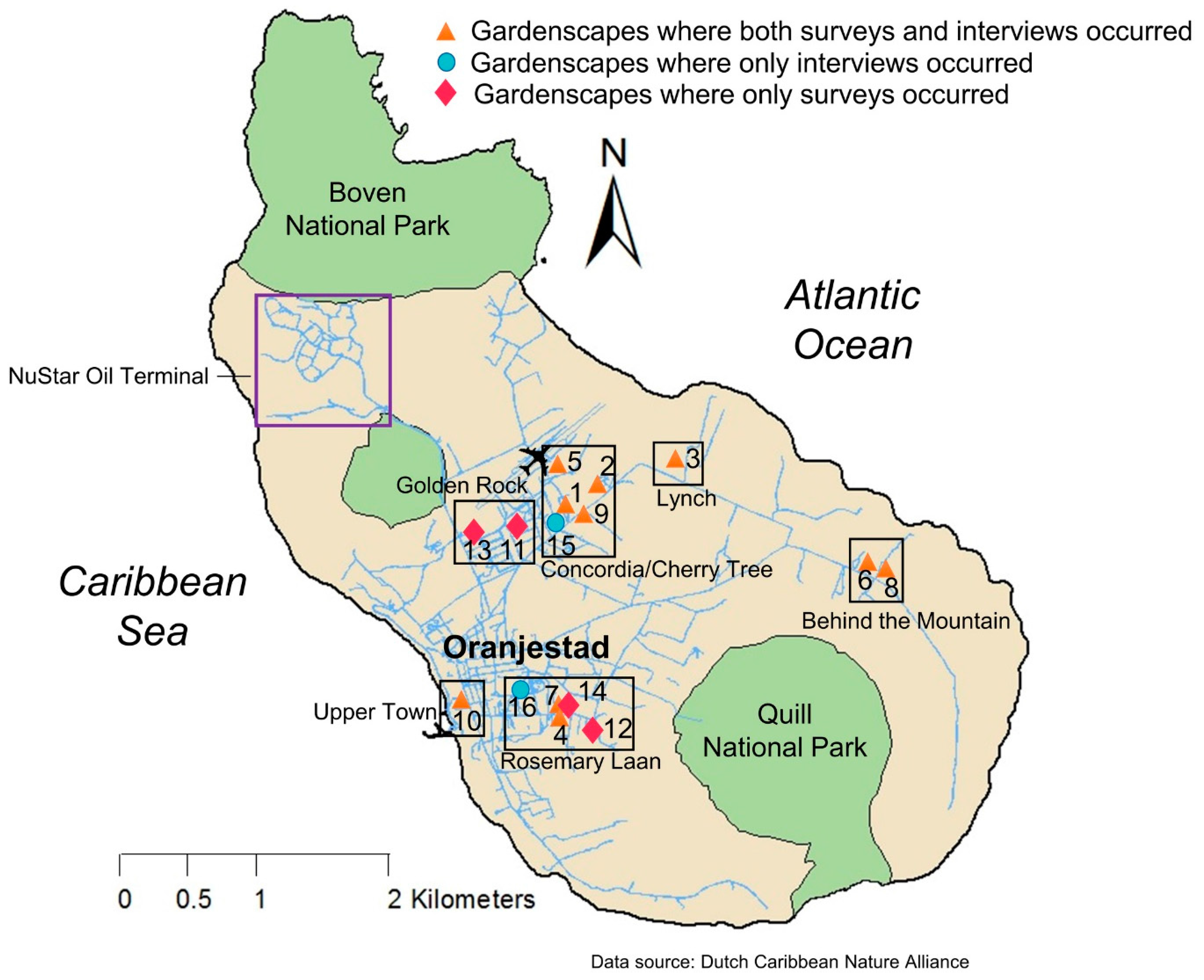
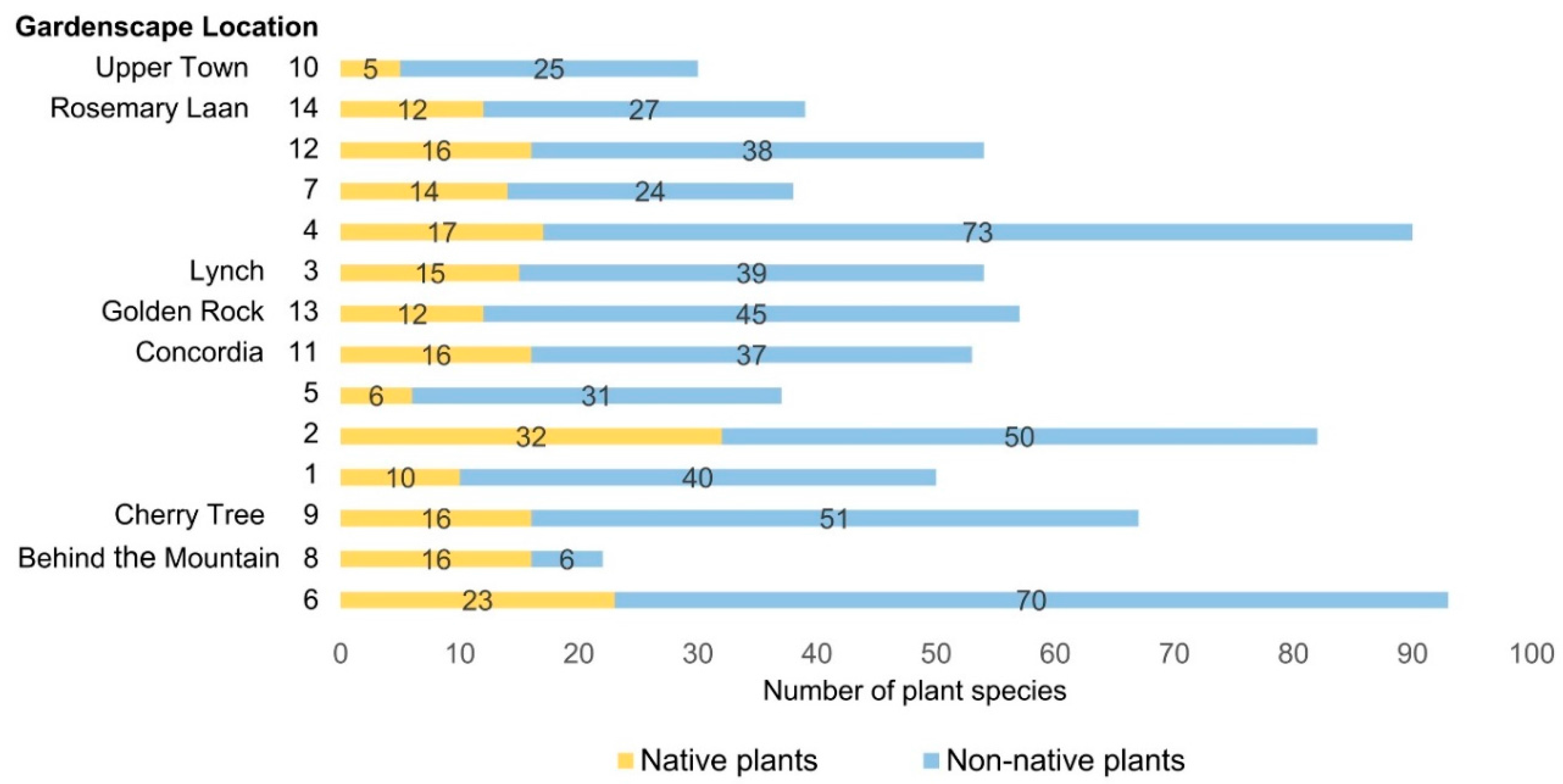

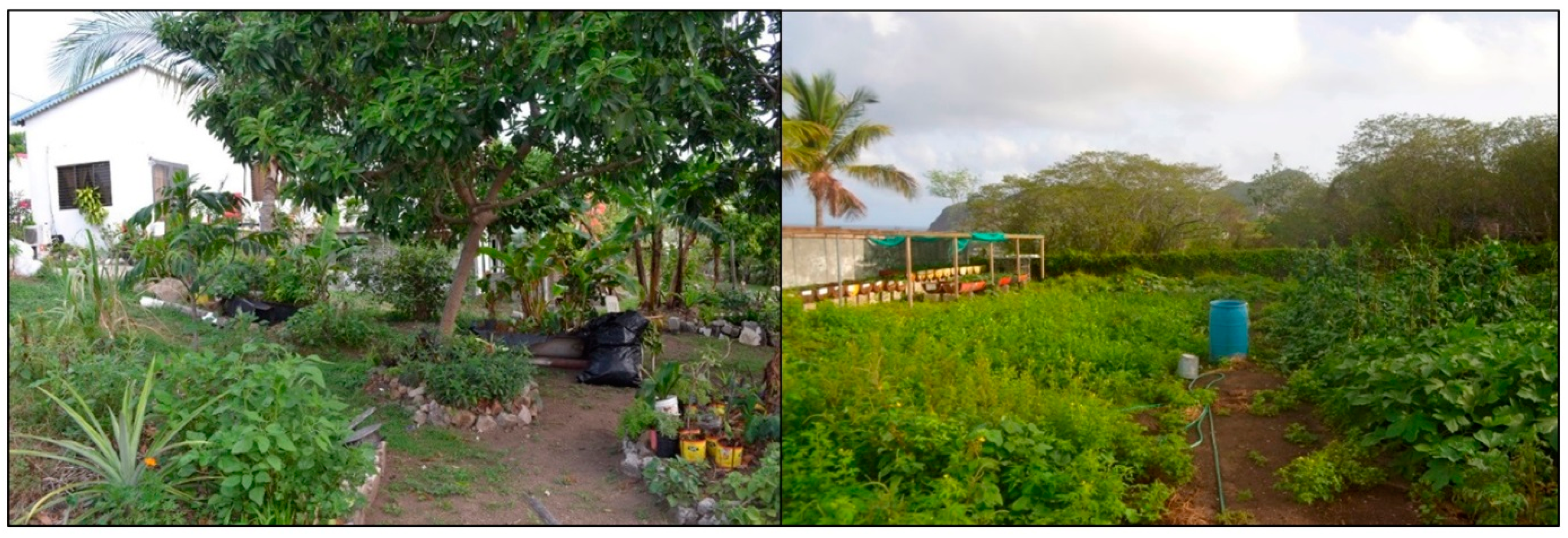
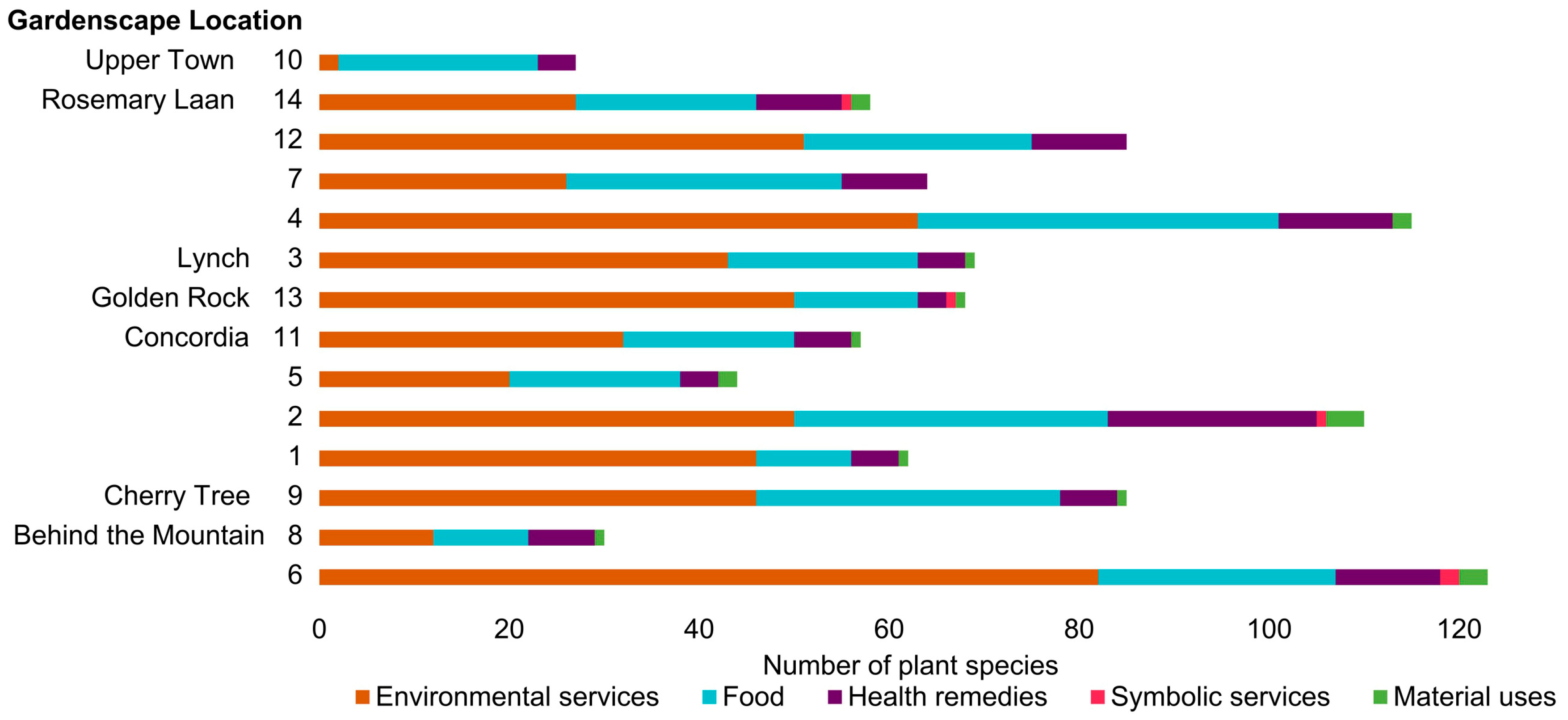
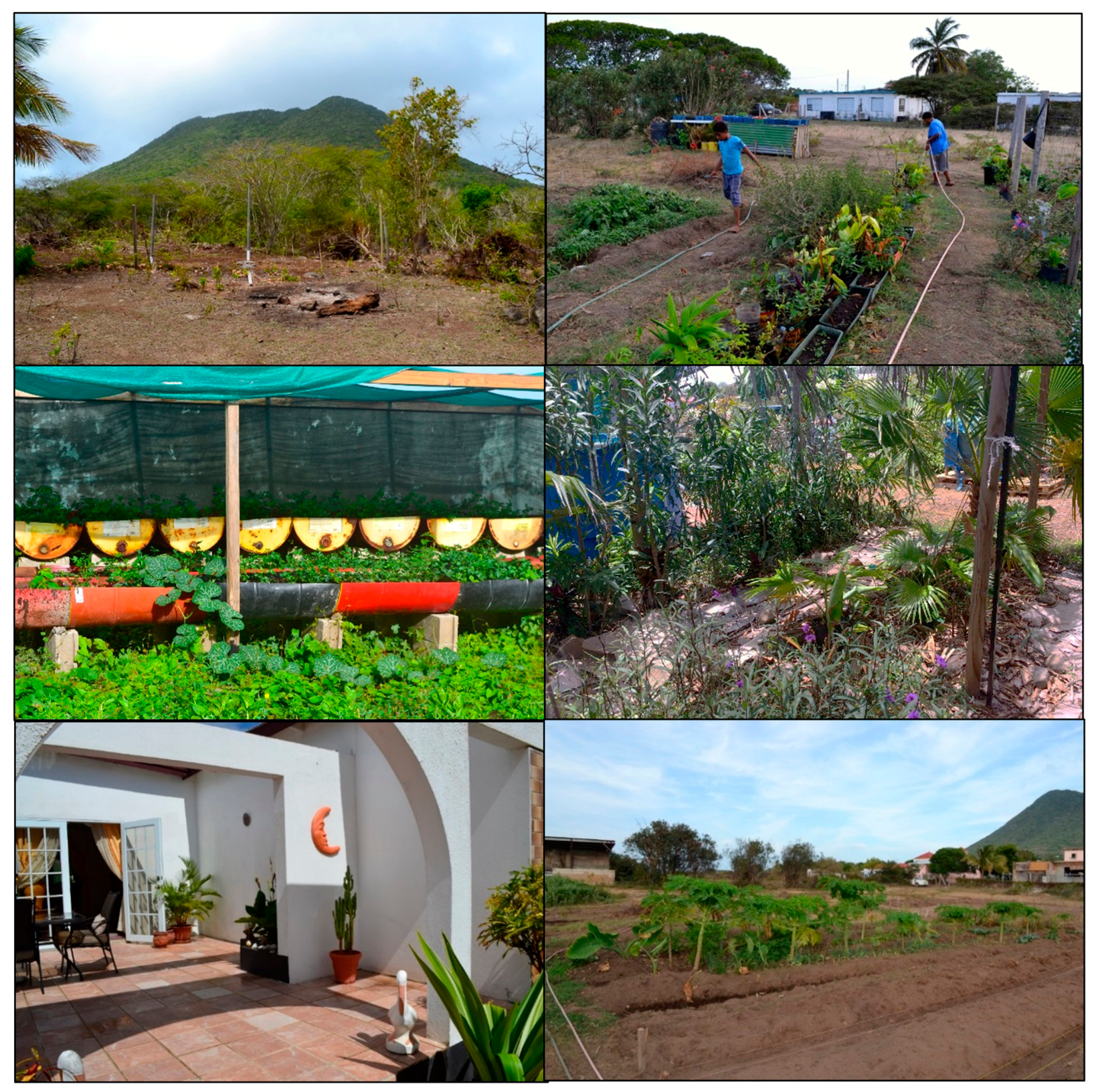
| Gardenscape (GS) | Size (m2) | Participants | Country of Origin | Length of Time at Gardenscape (Years) |
|---|---|---|---|---|
| Gardenscapes where surveys and interviews occurred | ||||
| 1 | 704 | Female | Aruba | 21 |
| 2 | 1132 | Female | St. Eustatius | 24 |
| 3 | 1750 1 | Male | St. Eustatius | “many decades“ |
| 4, 5 | 1116, 492 2 | Female | Dominica | “many years“ |
| 6 | 18171 | Female | United States | 7 |
| 7 | 6518 | Male | St. Eustatius | ~15 |
| 8 | 2243 | Male | St. Eustatius | 1 |
| 9 | 1077 | Female | St. Lucia | 10 |
| 10 | 685 3 | Male | Guyana | 2–3 |
| Gardenscapes where only surveys occurred | ||||
| 11 | 804 | Female | St. Eustatius | 25 |
| 12 | 906 | Female | St. Eustatius | not known |
| 13 | 500 | Couple | St. Kitts | not known |
| 14 | 1694 | Couple | St. Eustatius, UK | 3–4 |
| Gardenscapes where only interviews occurred | ||||
| 15 | Not surveyed | Female | The Netherlands | 5 |
| 16 | Not surveyed | Male | St. Eustatius | 2–3 |
| Transformation of The Garden Space |
|---|
| Where did you gain your plant and gardening knowledge? |
| What work did you do to create your gardenscape? |
| Does anyone else help you garden, and if so who? |
| How much time do you spend gardening? |
| Supporting Plant Diversity in Gardenscapes |
| Where did you acquire your plants (grew naturally, bought, given, etc.)? |
| What do you do to create positive change in your gardenscape? |
| What problems do you have managing your gardenscape? |
| Gardenscape Contributions to Homes and Livelihoods |
| How does your gardenscape and its plants contribute to your livelihood? |
| What importance does your gardenscape and its plants have in your life? |
| How has gardening on St. Eustatius changed over the years? |
| What opportunities do you currently see for gardening on St. Eustatius? |
| Origin Status | Number of Species (%) |
|---|---|
| Native—plants indigenous to an area. | 85 (31%) |
| Introduced (exotic)—plants transported across geographical barriers by humans. | 162 (58%) |
| Naturalized—non-native plants that sustain their populations. | 25 (9%) |
| Invasive—non-native plants that spread away from their site of introduction and outcompete native vegetation. | 5 (2%) |
| Use Categories | Recorded Uses (# of Species) | No. of Uses | No. of Species |
|---|---|---|---|
| Food | Side dish (1), edible leaves (6), edible stalks (4), edible bulbs (2), edible fruits (47), edible nuts (1), fruit used to make jam (2), fruit used to make juice (7), edible herb (9), adds fiber to diet (1), milk for tea and porridge (1), used to make oil (1), good source of starch (1), seeds used to flavor cooking (1), cut up and eat like string beans (1), makes a cooling drink (2), used for salad (2), edible roots (4), grind seeds to make coffee (1), good for flavoring soups, meat and salads (1), used to make a Christmas drink (1), ferment fruit to make wine (1), edible flowers (1), leaves good for tea (2), source of sugar (1) | 101 | 94 |
| Material uses | Used to cover charcoal pits (1), attracts fish so they are easier to catch (1), bowls and cups can be made from the fruit (1), good for making fences (1), powder from seeds used for skin decoration (1), repels mosquitos (1), used on hair (1), fish poison (1), animal fodder (1), can be used as a roof on structures for shade (1). | 10 | 9 |
| Symbolic services | Branches tied to fences/doors on independence day (1), cut for decorative flowers (1) | 2 | 2 |
| Health remedies | Tea to get rid of worms (1), (tea) for weight loss (2), (tea) for blood pressure (4), (tea) for diabetes (6), drink juice to treat diabetes (1), pieces of plant can be eaten to treat diabetes (1), jelly good for kidney and bladder (1), drink oil for colon (1), tie on foot if a nail or kasha plant is stepped on to prevent tetanus and draw out poison (1), good for eyes (1), tie on stomach to reduce pain (1), tea to cause an abortion (1), tea to stop bleeding (1), treatment for mosquito bites (1), used to “clean out” after having a baby (1), used to help a baby come out quicker during birth (1), (tea) for cough (2), (tea) for dengue (1), make powder from root for prostate problems (1), leaves draw down swelling (1), good for menstrual pain (2), tea to relieve pain (1), helps with memory (1), treats colds (1), rub leaves on wasp stings (1), chew a piece to go to sleep (1), makes a tincture for pain (1), general health remedy (1), apply to face to treat mumps (1), (tea) to stop diarrhea (1), chew roots to stop pain (1), make bush tea (1), drink juice to get rid of typhoid (1), leaves used to make tea (tea) to treat fever (4), used to make a treatment for prostate problems (1), treatment for sores (1) | 50 | 33 |
| Environmental services | Ornamental plant (184), drought resistant (3), good for shade (2), leaves can be put around plants to keep in moisture (1), hummingbirds like flowers (1), popular tree habitat for iguanas (1), used as a windbreak (2), can break off a stick and plant to quickly grow a tree (1), branches used to protect growing vegetables from livestock (1), boil leaves to make a tea that can be applied to plant leaves to get rid of/prevent pests (1), flowers attract bees (1), can grow on an arbor and have a greenhouse space underneath (1), fragrant flowers (1). | 200 | 187 |
| Totals | 363 | 260 |
| Island Location | Gardenscape (GS) | No. of Species | Species Density (#/m2) | Density (#/ha) | Evenness |
|---|---|---|---|---|---|
| Behind the Mountain | 6 | 92 | 0.05 | 3089 | 0.793 |
| 8 | 22 | 0.01 | 1937 | 0.640 | |
| Cherry Tree | 9 | 67 | 0.06 | 2374 | 0.869 |
| Concordia | 1 | 50 | 0.07 | 2455 | 0.843 |
| 2 | 82 | 0.07 | 3367 | 0.702 | |
| 5 | 37 | 0.08 | 2726 | 0.763 | |
| 11 | 53 | 0.07 | 1774 | 0.778 | |
| Golden Rock | 13 | 57 | 0.11 | 3953 | 0.856 |
| Lynch | 3 | 54 | 0.03 | 1689 | 0.803 |
| Rosemary Laan | 4 | 90 | 0.08 | 3193 | 0.872 |
| 7 | 38 | 0.01 | 640 | 0.757 | |
| 12 | 54 | 0.06 | 1910 | 0.875 | |
| 14 | 39 | 0.02 | 599 | 0.749 | |
| Upper Town | 10 | 30 | 0.04 | 794 | 0.796 |
| Average | 55 | 0.05 | 2179 | 0.793 |
© 2017 by the authors. Licensee MDPI, Basel, Switzerland. This article is an open access article distributed under the terms and conditions of the Creative Commons Attribution (CC BY) license (http://creativecommons.org/licenses/by/4.0/).
Share and Cite
Berkowitz, B.N.; Medley, K.E. Home Gardenscapes as Sustainable Landscape Management on St. Eustatius, Dutch Caribbean. Sustainability 2017, 9, 1310. https://doi.org/10.3390/su9081310
Berkowitz BN, Medley KE. Home Gardenscapes as Sustainable Landscape Management on St. Eustatius, Dutch Caribbean. Sustainability. 2017; 9(8):1310. https://doi.org/10.3390/su9081310
Chicago/Turabian StyleBerkowitz, Briana N., and Kimberly E. Medley. 2017. "Home Gardenscapes as Sustainable Landscape Management on St. Eustatius, Dutch Caribbean" Sustainability 9, no. 8: 1310. https://doi.org/10.3390/su9081310




